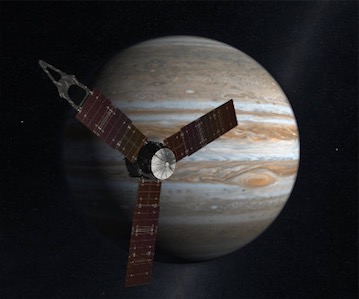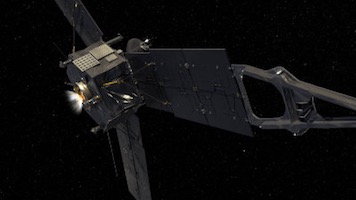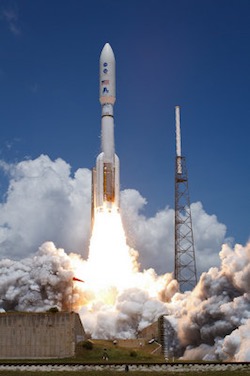Jupiter is the largest planet in our solar system with a diameter of about 143,000 kilometers (88,856 miles) at its equator. It is large enough that it could fit the combined masses of every other planet in the solar system, or it could contain the mass of 1,000 Earths, according to NASA. A gas giant, Jupiter’s atmosphere is largely composed of hydrogen and helium gases which cover a massive ocean of liquid metallic hydrogen creating the solar system’s most powerful magnetic field, one which is 20 times stronger than any magnetic field on Earth.
Since 1972, NASA has sent a series of eight spacecraft to this fifth planet in our solar system, including Cassini and Galileo. This 4th of July, NASA engineers and scientists are hoping for the successful arrival of Juno, the latest spacecraft to visit this massive planetary body. When it arrives at Jupiter, Juno will fire up its main engine for 35 minutes to enter an elliptical orbit around the planet. Juno’s mission will see it orbit Jupiter at least 37 times at a distance of 5,000 km (3,100 mi) from the top of Jupiter’s cloud atmosphere, the closest any craft has come to this planet.
As opposed to previous missions which have either zipped past the planet on their way towards primary objectives, or missions like Galileo dedicated to studying Jupiter’s moons, Juno will be the first to assay the planet’s interior. The mission intends on giving us a better sense of the origin and evolution of this gas giant as well as a greater understanding of what causes the aurora phenomenon found at the planet’s polar regions.
NASA’s Juno Mission: From Greek Myth to 21st Century Scientific Triumph
Many space enthusiasts will be well aware that the names of the planets in our solar system come from Ancient Roman mythology, but strangely enough the mission gets its name thanks to a Greek myth applied to the Roman pantheon. Jupiter and Juno are the Roman versions of the Greek Zeus and Hera, the former being the king of the gods on Mount Olympus and the latter his powerful and proud wife. In one myth, Zeus falls in love with the Argive princess Io and casts a cloud over the world to hide his tryst from Hera. The incredibly cunning Hera sees through these clouds and Zeus turns Io into a cow to hide the affair; Hera winds up asking Zeus for the cow as a present and Hera sends the heifer away to be constantly guarded. Interestingly, Io is one of the four moons of the Jovian system surrounding Jupiter, the densest of the Jovian moons and the most volcanically active body in our solar system.
In a similar way, NASA is hoping that Juno is able to unveil what Jupiter has hidden beneath its clouds to gain a greater understanding of how our solar system formed. According to the Juno mission web page at the Southwest Research Institute official website, Jupiter is the reason why the asteroid belt between that planet and Mars has not formed into a planet. Its gaseous atmosphere makes it similar to our own sun and other gas and dust clouds found throughout the Milky Way Galaxy. Juno has a number of scientific objectives such as determining the amount of water in Jupiter’s atmosphere, measuring cloud motion and mapping the planet’s gravitational and magnetic fields.
The scientific instruments installed on Juno, which weighs a total of four tons, aren’t exactly novel but have had to be configured in certain arrays in order to handle Jupiter’s massive size and radiation. The spacecraft is solar-powered and its rotational spin increases the ease of controlling and stabilizing the craft in orbit. Every two hours, Juno’s scientific instruments will have their fields of view cross Jupiter 400 times as the craft orbits between poles. Because of its distance from the sun, the furthest a solar-powered craft has ever flown, Juno’s three solar panels reach out to give the craft a span of 20 meters (66 feet).
To capture the most detailed pictures of Jupiter ever seen by man, Juno has been outfitted with a camera component known as JunoCam. The JunoCam is designed specifically to overcome issues posed by the rotational spin of Juno by capturing several lines of pixels at an image capture speed which eliminates any smear that could be caused by rotation. The camera uses four filters, including red, green, blue and near-infrared, to capture colored imagery and the lines of pixels are later stitched together to form coherent images. NASA researchers expect the JunoCam to return detailed images of the planet’s cloud bands as well as the first true images of the planet’s poles.
Jupiter’s aurora phenomenon will be further examined by the Jovian Infrared Auroral Mapper (JIRAM), an image spectrometer contributed to the Juno mission by the Italian Space Agency (ASI). JIRAM features two imaging components including an optical head to focus imaging and an electronics component capable of capturing both visible light and infrared emissions. Because of the intense radiation from Jupiter, JIRAM might only be operational for the first eight orbits around the planet.
Detecting the electrons and ions producing the large auroras seen on Jupiter will be the job of Juno’s Jovian Auroral Dynamics Experiment (JADE). JADE has three electron sensors which scan the magnetosphere in different directions for a total field of view of 120 degrees. JADE also has an ion instrument which measures three-dimensional ion distributions in the magnetosphere to perform the first direct measurements of the ions precipitating from Jupiter’s magnetosphere into the atmosphere, causing the aurora. A greater understanding of electron and ion interactions causing Jupiter’s auroras can show scientists on Earth how the magnetosphere differs between Jupiter and our own planet, which produces auroras but on a much smaller scale.
Despite it’s large size, Jupiter has the fastest rotational speed of any planet in our solar system with a rotational speed at its equator of 45,500 km per hour (28,273 miles per hour). It completes one full rotation every 9.9 hours. To get a sense of how this high speed of rotation affects how particles interact with the magnetosphere surrounding Jupiter, NASA researchers will consult the findings of the Jovian Energetic Particle Detector Instrument (JEDI). JEDI involves a series of three shoebox-sized electronic detectors positioned for a 360 degree field of view which will measure the highest energy particles spinning away from the planet. The findings will help scientists understand the structure and characteristics of Jupiter’s upper atmosphere and provide more insights into the aurora formation which is so strong on this planet. JEDI was constructed by engineers working at the Johns Hopkins Applied Physics Laboratory.
The central hub of the Juno craft between the three solar panel arrays houses the components used for the Gravity Science Experiment which aims to help NASA researchers understand the structure of Jupiter’s core. The experiment utilizes two transponders communicating on different frequencies which transmit and collect radio signals traveling between an 111.5-foot (34-meter) radio antenna located in Goldstone, CA. Radio signal transmissions can be measured to determine the Doppler shift effect that occurs whenever Juno is pulled out of its planned orbit because of Jupiter’s gravitational pull. Depending on how much gravity is acting upon Juno, scientists will be given a greater understanding as to whether Jupiter is composed completely of gas or whether it has a solid core.
This is by no means an exhaustive list of the scientific instruments carried by Juno. The Ultraviolet Imaging Spectrograph (UVS) uses spectrography techniques to observe far-ultraviolet auroral emissions on Jupiter to gain more insight into how auroras on Jupiter form, which could uncover key findings as to why auroras occur on Earth. The Microwave Radiometer (MWR) measures radiation in the microwave region to gain an understanding of the thermal radiation emitting from Jupiter beneath the upper cloud layer. This will give researchers the ability to map a representation of Jupiter’s lower atmosphere levels and determine the amount of oxygen, nitrogen and sulfur in those atmospheric levels. There’s also a four-meter long magnetometer situated at the end of one of Juno’s solar panel arrays that will work to map Jupiter’s magnetic field and determine dynamics of the planet’s interior.
The large size of Jupiter’s magnetic field means that the planet emits a high amount of sub-atomic radiation which could be damaging to the electronic components of Juno’s many scientific instruments. To protect electronic components from these tiny particles, the centralized electronics hub has been encased within a radiation vault weighing about 200 kilograms (500 pounds) and constructed of titanium. The vault cannot protect the electronics from all fast-moving sub-atomic particles but it can slow the damage they cause. Juno’s orbital path between Jupiter’s poles is also designed to reduce the impact of radiation on the craft.
Juno’s Five-Year Journey to Jupiter
Juno is the second mission planned under the NASA’s New Frontiers program of principal investigator-led missions which are designed to research and uncover new knowledge of planetary bodies within our solar system. The first of these missions, New Horizons, zipped past Pluto last July on its way to the Kuiper Belt to understand more about the planetary bodies at the furthest reaches of our solar system.
The Juno launch took place at 12:25 PM EDT on August 5th, 2011, when an Atlas V rocket sent Juno into outer space. In a little more than a year, Juno completed two deep space maneuvers, both involving the firing of Juno’s main engine to refine the craft’s trajectory en route to an Earth flyby assist in 2013.
The deep space maneuvers took place at a distance of 480 million km (298 million mi) from Earth. To pick up the speed necessary to jettison the craft towards the fifth planet in our solar system, Juno completed an Earth flyby in October 2013 which increased the craft’s speed by about 3.9 km per second, or 8,800 mph. During the flyby, Juno came within 348 miles of Earth’s surface allowing it to dig deep into Earth’s gravitational field to ‘slingshot’ out at a high speed.
Once Juno makes a successful transition into an orbital path around Jupiter, the craft will remain for a total of 20 months during which time it will attempt to complete 37 orbits of the planet. In February 2018, Juno will be decommissioned and the craft will deorbit into Jupiter’s atmosphere where it will burn up and be destroyed.

![[IPWatchdog Logo]](https://ipwatchdog.com/wp-content/themes/IPWatchdog%20-%202023/assets/images/temp/logo-small@2x.png)


![[[Advertisement]]](https://ipwatchdog.com/wp-content/uploads/2023/01/2021-Patent-Practice-on-Demand-1.png)


![[Advertisement]](https://ipwatchdog.com/wp-content/uploads/2024/04/Artificial-Intelligence-2024-REPLAY-sidebar-700x500-corrected.jpg)
![[Advertisement]](https://ipwatchdog.com/wp-content/uploads/2024/04/UnitedLex-May-2-2024-sidebar-700x500-1.jpg)
![[Advertisement]](https://ipwatchdog.com/wp-content/uploads/2024/04/Patent-Litigation-Masters-2024-sidebar-700x500-1.jpg)

![[Advertisement]](https://ipwatchdog.com/wp-content/uploads/2021/12/WEBINAR-336-x-280-px.png)
![[Advertisement]](https://ipwatchdog.com/wp-content/uploads/2021/12/2021-Patent-Practice-on-Demand-recorded-Feb-2021-336-x-280.jpg)
![[Advertisement]](https://ipwatchdog.com/wp-content/uploads/2021/12/Ad-4-The-Invent-Patent-System™.png)






Join the Discussion
2 comments so far.
Tom
July 3, 2016 08:32 amThanks for all the detail. Titanium vault??!! I’ll have to search for a picture of that one.
Night Writer
July 2, 2016 08:07 pmSo cool. We should be spending the space money to advance science as much as possible like this one.